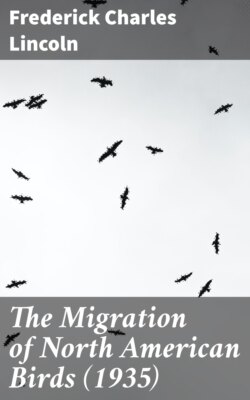Читать книгу The Migration of North American Birds (1935) - Frederick Charles Lincoln - Страница 6
На сайте Литреса книга снята с продажи.
ADVANTAGES OF MIGRATION
ОглавлениеTable of Contents
Before presenting some of the present theories concerning the origin of bird migration, it seems well to consider briefly the ends served by this annual round trip between breeding grounds and winter quarters. It is apparent that the migratory habit enables a species to enjoy the summers of northern latitudes while avoiding the severity of the winters. In other words, migration makes it possible for some species to inhabit two different areas at seasons when each presents favorable conditions. In the performance of its reproductive duties every pair of birds requires a certain domain, the extent of which varies greatly in different species. Generally, however, this territory must be large enough to provide adequate food, not only for the parent birds but also for the lusty appetites that come into being with the hatching of the eggs. Thus, if all birds were to remain constantly either in tropical or in temperate regions, there might be intolerable overcrowding during the breeding season. By the spring withdrawal to regions uninhabitable earlier in the year, the migrants are assured of adequate space and ample food upon their arrival in the winter-freed North, and it may be assumed that nonmigrant species resident in the South are benefited by the withdrawal of the migrants.
Nevertheless it cannot be said that the winter or summer areas are entirely unsuited to the requirements of every migrating species at other seasons, for some individuals pass the winter in areas that are frequented only in summer by other individuals of their species. The extensive breeding ranges of such species present wide climatic variations, so that some individuals may actually be resident in a region where others of their kind are present only in winter.
The tendency in many species to move southward at the approach of winter is not always due to the seasonal low temperatures, since experiments have demonstrated that many summer insect feeders, when confined in outdoor aviaries, comfortably withstand temperatures far below zero. The main consideration is the depletion of the food supply, caused either by disappearance or hibernation of insects, or by the mantle of snow or ice that prevents access to the seeds and other forms of food found on or close to the ground or submerged in water. Possibly also the shortened hours of daylight materially restrict the ability of the birds to obtain sufficient food at a time when the cold requires an increased supply to maintain body heat. It is noteworthy that chickadees (Penthestes atricapillus) and some other of our smaller birds have no fear of Arctic weather, as their food supplies are mainly arboreal and so are always available. Also, when there is a good supply of food in the form of pine seeds in Canadian woods, nuthatches (Sitta carolinensis and S. canadensis) and crossbills (Loxia curvirostra and L. leucoptera) will remain through the winter. When these birds appear abundantly in winter at points in southern latitudes, it may be concluded that there is a shortage of their food in the North, or that they have been lured farther south by the greater abundance of this food there.
